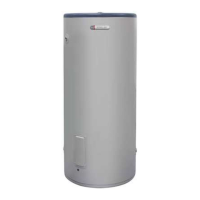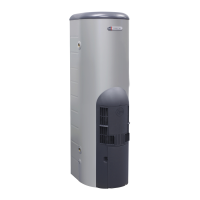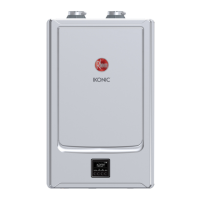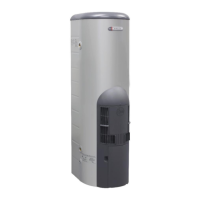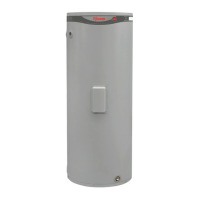En-5
5.6. Flare connection (Pipe connection)
CAUTION
Tighten the fl are nuts with a torque wrench using the specifi ed tightening method. Oth-
erwise, the fl are nuts could break after a prolonged period, causing refrigerant to leak
and generate hazardous gas if the refrigerant comes into contact with a fl ame.
5.6.1. Flaring
Use special pipe cutter and fl are tool exclusive for R410A.
(1) Cut the connection pipe to the necessary length with a pipe cutter.
(2) Hold the pipe downward so that cuttings will not enter the pipe and remove any burrs.
(3) Insert the fl are nut (always use the fl are nut attached to the indoor unit(s) and outdoor
unit respectively) onto the pipe and perform the fl are processing with a fl are tool. Use
the special R410A fl are tool, or the conventional fl are tool. Leakage of refrigerant may
result if other fl are nuts are used.
(4) Protect the pipes by pinching them or with tape to prevent dust, dirt, or water from en-
tering the pipes.
Die
A
Pipe
B
L
Check if [L] is flared uniformly and
is not cracked or scratched.
Pipe outside diameter
[in. (mm)]
Dimension A [in. (mm)]
Dimension B [in. (mm)]
Flare tool for R410A,
clutch type
1/4 (6.35)
0 to 0.020
(0 to 0.5)
3/8 (9.1)
3/8 (9.52)
1/2 (13.2)
1/2 (12.70)
5/8 (16.6)
5/8 (15.88)
3/4 (19.7)
3/4 (19.05)
15/16 (24.0)
When using conventional fl are tools to fl are R410A pipes, the dimension A should be
approximately 0.020 in. (0.5 mm) more than indicated in the table (for fl aring with R410A
flare tools) to achieve the specified flaring. Use a thickness gauge to measure the
dimension A.
Width across
flats
Pipe outside
diameter [in. (mm)]
Width across flats of
Flare nut [in. (mm)]
1/4 (6.35)
11/16 (17)
3/8 (9.52)
7/8 (22)
1/2 (12.70)
1 (26)
5/8 (15.88)
1-1/8 (29)
3/4 (19.05)
1-7/16 (36)
5.6.2. Bending pipes
• If pipes are shaped by hand, be careful not to collapse them.
• Do not bend the pipes in an angle more than 90°.
• When pipes are repeatedly bend or stretched, the material will harden, making it diffi cult
to bend or stretch them anymore.
• Do not bend or stretch the pipes more than 3 times.
CAUTION
• To prevent breaking of the pipe, avoid sharp bends.
• If the pipe is bent repeatedly at the same place, it will break.
5.6.3. Pipe connection
CAUTION
• Be sure to Install the pipe against the port on the indoor unit correctly. If the center-
ing is improper, the fl are nut cannot tighten smoothly. If the fl are nut is forced to
turn, the threads will be damaged.
• Do not remove the fl are nut from the indoor unit pipe until immediately before con-
necting the connection pipe.
• Hold the torque wrench at its grip, keeping it in the right angle with the pipe, in order
to tighten the fl are nut correctly.
• Tighten the fl are nuts with a torque wrench using the specifi ed tightening method.
Otherwise, the fl are nuts could break after a prolonged period, causing refrigerant
to leak and generate hazardous gas if the refrigerant comes into contact with a
fl ame.
CAUTION
• Connect the piping so that the control box cover can easily be removed for servic-
ing when necessary.
• In order to prevent water from leaking into the control box, make sure that the pip-
ing is well insulated.
When the flare nut is tightened properly by your hand, hold the body side coupling with a
wrench, then tighten with a torque wrench. (See the following table for the flare nut tight-
ening torques.)
Tighten with two wrenches.
Holding wrench
Flare nut
Connection pipe
Torque wrench
Indoor unit pipe
(Body side)
Flare nut [in. (mm)] Tightening torque [lb·ft (N·m)]
1/4 (6.35) dia. 11.8 to 13.3 (16 to 18)
3/8 (9.52) dia. 23.6 to 31.0 (32 to 42)
1/2 (12.70) dia. 36.1 to 45.0 (49 to 61)
5/8 (15.88) dia. 46.5 to 55.3 (63 to 75)
3/4 (19.05) dia. 66.4 to 81.1 (90 to 110)
6. ELECTRICAL WIRING
6.1. Wiring system diagram
WARNING
• Before connecting the wires, make sure the power supply is OFF.
• Every wire must be connected fi rmly.
• No wire should be allowed to touch refrigerant tubing, the compressor or any mov-
ing part.
• Loose wiring may cause the terminal to overheat or result in unit malfunction. A fi re
hazard may also exist. Therefore, be sure all wiring is tightly connected.
• Connect wires to the matching numbers of terminals.
14AWG
(Inter-unit)
INDOOR UNIT SIDE
INDOOR UNIT
TERMINAL
DISCONNECT
SWITCH
(Locally purchased)
Power line
Control line
Earth
(ground) line
OUTDOOR UNIT
Connect it to
the specifi ed
terminal.
Disconnect switch - locally purchased if required by local code. Select the correct capacity
of disconnect switch according to the load.
Earth
(Ground)
screw
Disconnect switch
Indoor unit
terminal block
Outdoor unit
Connect it to
the specifi ed
terminal.
9318739237_IM.indb 59318739237_IM.indb 5 11/30/2016 9:59:20 AM11/30/2016 9:59:20 AM

